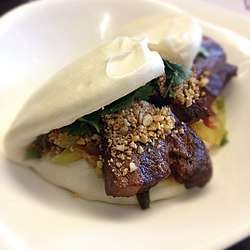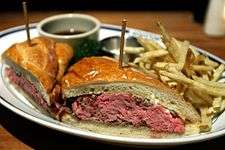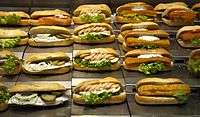Gua bao
 A traditional gua bao | |
| Alternative names | Steamed bao, hó͘-kā-ti, pork belly bun |
|---|---|
| Course | Snack |
| Place of origin | Fuzhou, Fujian, China |
| Region or state | Fuzhou and Taiwan |
| Serving temperature | Hot |
| Main ingredients | Steamed bread, stewed meat, condiments |
| Ingredients generally used | Red-cooked pork belly, pickled mustard, coriander, ground peanuts |
| Variations | Fried chicken, fish, eggs, stewed beef |
Gua bao (Traditional Chinese: 割包; Simplified Chinese: 刈包; Pinyin: guàbāo; Pe̍h-ōe-jī: koah-pau; literally: "cut bread"),[1] also known as steamed bao[2], Taiwanese Hamburger[3], pork belly buns[4], or ambiguously, bao,[5][6] is a xiaochi dish originating from Fuzhou[7], the capital of Fujian province, with similar variants found across China, and a popular Taiwanese street food.
It consists of a slice of stewed meat and other condiments sandwiched between flat steamed bread known as lotus leaf buns. The lotus leaf bun is typically 6–8 centimetres (2.4–3.1 in) in size, semi-circular and flat in form, with a horizontal fold that, when opened, gives the appearance that it has been sliced. The traditional filling for gua bao is a slice of red-cooked porkbelly, typically dressed with stir-fried suan cai (pickled mustard greens), coriander, and ground peanuts.[6][8][9]
History
Gua bao originated in Fuzhou and were brought over to Taiwan by Fuzhounese immigrants[10][11] where the flavors were modified to suit local tastes. In Taiwan they are sometimes referred to as Chinese hamburgers[12] although Westerners generally refer to Roujiamo as "Chinese hamburgers"[13][14]. The food is known colloquially in parts of Taiwan as hó͘-kā-ti (虎咬豬; "tiger bites pig") due to the mouth-like form of the bun and the contents of the filling.[8][15] Chef, writer, and food historian Fuchsia Dunlop states that lotus leaf buns are a traditional Chinese accompaniment to rich dishes such as bowl-steamed pork in rice meal or roast duck and thus the buns support a wide array of fillings with gua bao being just one style which utilises pork belly. A lotus leaf bun by itself is called a "he ye bing" but with filings is called a "he ye bao".[16]
Gua bao became popular in the West through chef David Chang's Momofuku restaurants although he says that he was unaware that the gua bao dish already existed and that his Momofuku pork buns recipe was inspired by his dining experiences in Beijing and Manhattan Chinatown's Oriental Garden where the Peking duck was served in lotus leaf buns rather than the traditional spring pancake.[17] The name "gua bao" was used and popularised by chef Eddie Huang when he opened his BaoHaus restaurant.[18] In the United Kingdom they are often called hirata buns, named after Masashi Hirata, the executive chef of Ippudo in New York as many ramen restaurants began to adopt selling gua bao alongside their ramen dishes due to the influence of Momofuku.[19]
In Hong Kong, they are known as cha bao which means "fork buns" as the sandwiches are usually pierced by a toothpick or wooden skewer to keep the fillings in place. In Japan they are called kakuni manju[20] and are sold as a Chinese snack food. They are a specialty of Nagasaki Chinatown[21], having been sold in Japan for centuries[22] due to the large number of Fuzhounese immigrants and historic relations between Fuzhou and Nagasaki represented by the construction of Sofukuji Temple[23][24]. Recognizing the Fuzhounese community and historical connection, Nagasaki and Fuzhou established ties as sister cities in 1980.[25] Another iconic Nagasaki dish of Fujianese origin is champon.
In the West, there have been many new trendy "gua bao" which incorporate pan-Asian fusion or non-traditional items stuffed between the lotus leaf buns, such as kimchi or karaage[26]. Although these are technically not gua bao at all as they do not include pork belly[27], and in China would only be considered different lotus leaf bun sandwiches (he ye bao).
See also
References
- ↑ "Entry #8213 (割包)". 臺灣閩南語常用詞辭典 [Dictionary of Frequently-Used Taiwan Minnan] (in Chinese and Hokkien). Ministry of Education, R.O.C. 2011.
- ↑ Sufrin, Jon (February 5, 2014). "Banh Mi Boys will soon open Lucky Red, a new bao shop in Chinatown". Toronto Life.
- ↑ Wong, Maggine (August 31, 2018). "The secret of gua bao: The Taiwanese street food taking over the world". CNN.
- ↑ Erway, Cathy (April 2, 2014). "Taiwanese Pork Belly Buns (Gua Bao)".
- ↑ L., Mandy (February 6, 2013). "Who Took the "Gua" out of "Bao".
- 1 2 Glassberg, Julie (February 23, 2010). "Baohaus". The New York Times.
- ↑ "Take a bao". chinatown.co.uk.
- 1 2 "Gwa-Bao (割包 Braised Pork Wrapped in Steamed Buns)". Ministry of Foreign Affairs, Republic of China (Taiwan). 2011.
- ↑ Erway, Cathy. The Food of Taiwan: Recipes from the Beautiful Island. Houghton Mifflin Harcourt. ISBN 9780544303010.
- ↑ "大口/Q彈有勁福州吃法! 台南‧阿松割包". nrch.culture.tw.
- ↑ "老字號割包店 肉香Q嫩不油膩-華視新聞-華視新聞網". news.cts.com.tw.
- ↑ "刈包". nrch.culture.tw.
- ↑ Alison Spiegel. "What Are Chinese Hamburgers And Why Aren't You Eating Them?". huffingtonpost.com.
- ↑ Mads Schmidt. "Call it a Chinese hamburger". gbtimes.com.
- ↑ 味蕾 (April 13, 2010). 【美食典故】割包刈包虎咬豬. The Epoch Times.
- ↑ Dunlop, Fuchsia. Every Grain of Rice. W. W. Norton Company. Kindle Edition.
- ↑ "Momofuku's pork buns". gourmettraveller.com.au/.
- ↑ Wong, Maggine (August 31, 2018). "The secret of gua bao: The Taiwanese street food taking over the world". CNN.
- ↑ "Trendspotting: Hirata buns". blogs.timeout.jp.
- ↑ "刈包". ettoday.net/.
- ↑ "A Guide to Nagasaki Shinchi Chinatown: Enjoy Local Specialties as You Walk!". wow-j.com.
- ↑ "Episode 9: Kyushu". sbs.com.au/.
- ↑ "The first Chinese style temple in Nagasaki". japan-kyushu-tourist.com.
- ↑ "Sofukuji Temple (崇福寺)". travel.navitime.com.
- ↑ "Interchange Fuzhou City between cities". city.nagasaki.lg.jp.e.jc.hp.transer.com.
- ↑ "CHICKEN KARAAGE & KIMCHI BAO". hakka.com.au.
- ↑ 味蕾 (April 13, 2010). 【美食典故】割包刈包虎咬豬. The Epoch Times.


